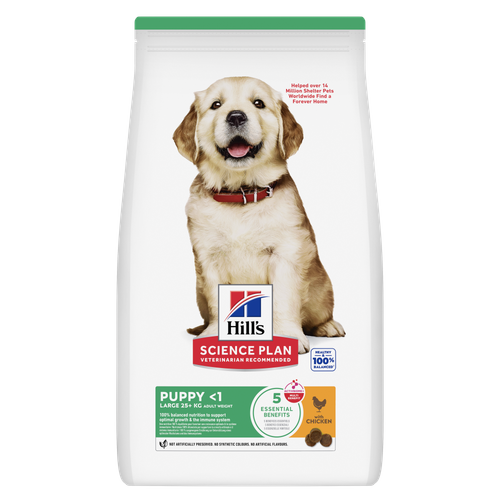
-
Trouvez la nourriture adaptée à votre animal de compagnieRépondez à ce quiz pour découvrir quelle alimentation conviendrait le mieux à votre compagnon à quatre pattes.Trouvez la nourriture adaptée à votre animal de compagnieRépondez à ce quiz pour découvrir quelle alimentation conviendrait le mieux à votre compagnon à quatre pattes.Produits recommandés
 Puppy Small & Mini - Croquettes pour Chiot - Petite et très Petite Race
Puppy Small & Mini - Croquettes pour Chiot - Petite et très Petite RaceHill’s Science Plan Puppy Small & Mini - Croquettes pour Chiot à l’Agneau & Riz - Petite et très Petite Race est un aliment complet spécialement formulé avec la technologie ActivBiome+ Multi-Benefit.
Aliment équilibré pour renforcer le système immunitaire et assurer une croissance optimale.Shop Now Puppy - Croquettes pour Chiot - Grande Race
Puppy - Croquettes pour Chiot - Grande RaceHill’s Science Plan Puppy - Croquettes pour Chiot au Poulet - Grande Race est un aliment complet spécialement formulé avec la technologie ActivBiome+ Multi-Benefit.
Aliment équilibré pour renforcer le système immunitaire et assurer une croissance optimale.Shop Now Senior Vitality - Croquettes pour Chien Mature (7+) - Petite Race - au Poulet et Riz
Senior Vitality - Croquettes pour Chien Mature (7+) - Petite Race - au Poulet et RizHill’s Science Plan Senior Vitality - Croquettes pour Chien au Poulet - Petite et très Petite Race Notre formule révolutionnaire favorise la capacité quotidienne de votre chien senior à se lever et à bouger.
Shop NowProduits recommandés Oral Care - Croquettes pour Chat Adulte (1+)
Oral Care - Croquettes pour Chat Adulte (1+)Hill’s Science Plan - Oral Care - Croquettes pour Chat Adulte au Poulet sont des croquettes cliniquement prouvées pour réduire l’accumulation de plaque dentaire et de tartre.
Shop Now Hairball & Perfect Coat - Croquettes pour Chat Adulte - au Poulet
Hairball & Perfect Coat - Croquettes pour Chat Adulte - au PouletHill's Science Plan Hairball & Perfect Coat - Croquettes pour Chat Adulte - au Poulet a été formulé pour aider efficacement à éviter la formation de boules de poils chez le chat adulte tout en favorisant un beau pelage. Grâce à son mélange d’acides gras essentiels Oméga-6, cet aliment est bénéfique pour la peau et le pelage du chat, les maintenant sains et brillants. Notre technologie Advanced Fibre aide à réduire les boules de poils en favorisant naturellement leur passage dans l’intestin. Cet aliment est formulé avec des protéines de haute qualité pour une recette parfaitement équilibrée et savoureuse.
Shop Now Sensitive Stomach & Skin - Sachet Repas pour Chat
Sensitive Stomach & Skin - Sachet Repas pour ChatHill’s Science Plan Sensitive Stomach & Skin Sachet Repas pour Chat Adulte à la Dinde est un aliment complet pour les chats adultes âgés de 1 à 6 ans. Cette alimentation hautement digestible se présente en sachet repas et favorise une meilleure digestion, nourrit la peau et rend le pelage épais et brillant.
Shop Now -
Pour chienPour chatArticles à la une
 Les bonnes résolutions pour la nouvelle année avec votre animal | Hill's Pet
Les bonnes résolutions pour la nouvelle année avec votre animal | Hill's PetÀ la fin de l'année, de nombreuses personnes fête la nouvelle année en créant une liste de nouvelles habitudes à adopter (ou à abandonner !) pour améliorer leur santé et leur bonheur.
Read More Fêtez la nouvelle année avec ces résolutions pour vos animaux
Fêtez la nouvelle année avec ces résolutions pour vos animauxÀ la fin de l'année, de nombreuses personnes fête la nouvelle année en créant une liste de nouvelles habitudes à adopter (ou à abandonner !) pour améliorer leur santé et leur bonheur.
Read More Idées de jeux pour les enfants et les animaux cet été
Idées de jeux pour les enfants et les animaux cet étéLes activités d’été en plein air avec votre chien ou chat peuvent être tout aussi divertissantes pour les enfants. Découvrez comment ces activités leur enseignent le sens des responsabilités et les aident à créer des liens avec leurs animaux.
Read More -


The government has announced that as of April 2016, all dogs in the UK must be microchipped by law. Many owners don’t necessarily know how microchipping works though and this can lead to the system breaking down, so Hill’s has laid out the facts in one easy reference guide.
The new laws regarding compulsory microchipping for dogs in the UK have been introduced with the hope of reuniting more lost or stolen pets with their owners, reducing the number of stray animals and helping with the prosecution of more owners of dangerous dogs. This is to the delight of organisations such as The Blue Cross, who have been campaigning for such a move for a long time. Laws have also been changed to ensure that dog attacks on private property can no longer automatically go unpunished, encouraging more responsible dog ownership and hopefully reducing UK dog attack statistics.
Authorities such as the The National Dog Warden Association and Dog’s Trust warn that owners need to be aware that microchipping their pet is only the first step towards the system working though. So how does microchipping actually work and what do owners need to do to make sure that their pet is protected in the long-term?
How A Microchip Works
- Each chip is programmed with a unique number that is transmitted when the chip is scanned by a specialised microchip reader.
- This number is associated with the owner’s details in a national database. Because it is a number rather than actual contact details that the chip transmits, any changes to owner details can be made easily and data is protected.
- All vets, council run dog kennels (where strays are taken by a dog warden) and many rescue centres have microchip readers/scanners.
- Regardless of chip manufacturer, all UK readers will scan all UK microchips and the various UK pet owner databases work together to share information when trying to locate a microchipped pets’ owner.
“When our dog Bella went missing and we had heard nothing after a week of desperately trying to find her, we started to lose hope. Then we got a call from a vet saying that they had scanned her microchip after someone had brought her in to them and she was back home within the hour!”
Mr Fairweather, Devon


Conseils savoureux
Les chiots peuvent nécessiter plusieurs visites de vaccination au cours de leur première année. Les chiens adultes bénéficient généralement d'un contrôle annuel, tandis que les chiens âgés ou ayant des besoins spécifiques peuvent nécessiter des visites plus fréquentes.
How A Microchip Is Fitted
- A pre-loaded sterile syringe allows the microchip to be inserted just under the skin, between the shoulder blades.
- Insertion is a quick and straightforward procedure that does not require an anaesthetic.
- Insertion can be performed from as young as one day old.
- The insertion procedure is no more painful than a usual vaccination injection and rarely bleeds. If there is any bleeding, it can be stopped quickly by applying a little pressure.
- Microchips are coated in a special type of glass identical to that used in human pacemakers, so the dog’s body does not try to reject it.
“I was really worried about having Scooby microchipped as a puppy because he was so small. He didn’t bat an eyelid though and was more interested in eating a treat and sniffing the table whilst it was inserted! It’s now been in there for five years with no problems.”
Mrs Francis, Surrey
Making Sure A Microchip Stays Effective
- Microchips only work if the contact details associated with the unique chip number are kept up to date by owners. This is usually done by simply phoning the microchip database company – check any microchip paperwork or ask your vet for details.
- Microchips can sometimes move from where they were originally inserted and (rarely) even come out altogether (usually soon after insertion). Very rarely, they stop working entirely, so regular checks are important. Annual vaccinations are a good time to do this, but ‘chip checks’ can also often be done at the vets without an appointment or charge.
“Owners of microchipped pets must remember to keep their contact details updated. 40% of the dogs we pick up that are chipped have got incomplete or inaccurate data, meaning they can't be returned."
The National Dog Warden Association


L'un de nos auteurs a préparé cet article pour vous
Produits Similaires

Hill’s Science Plan Senior Vitality - Croquettes pour Chien au Poulet - Petite et très Petite Race Notre formule révolutionnaire favorise la capacité quotidienne de votre chien senior à se lever et à bouger.

Hill’s Science Plan Puppy - Croquettes pour Chiot au Poulet - Grande Race est un aliment complet spécialement formulé avec la technologie ActivBiome+ Multi-Benefit.
Aliment équilibré pour renforcer le système immunitaire et assurer une croissance optimale.

Hill’s Science Plan Puppy Small & Mini - Croquettes pour Chiot à l’Agneau & Riz - Petite et très Petite Race est un aliment complet spécialement formulé avec la technologie ActivBiome+ Multi-Benefit.
Aliment équilibré pour renforcer le système immunitaire et assurer une croissance optimale.

Hill’s Science Plan Puppy Medium - Croquettes pour Chiot au Poulet - Moyenne Race est un aliment complet spécialement formulé avec la technologie ActivBiome+ Multi-Benefit.
Aliment équilibré pour renforcer le système immunitaire et assurer une croissance optimale.
Articles Similaires

Les activités d’été en plein air avec votre chien ou chat peuvent être tout aussi divertissantes pour les enfants. Découvrez comment ces activités leur enseignent le sens des responsabilités et les aident à créer des liens avec leurs animaux.

À la fin de l'année, de nombreuses personnes fête la nouvelle année en créant une liste de nouvelles habitudes à adopter (ou à abandonner !) pour améliorer leur santé et leur bonheur.

À la fin de l'année, de nombreuses personnes fête la nouvelle année en créant une liste de nouvelles habitudes à adopter (ou à abandonner !) pour améliorer leur santé et leur bonheur.

En savoir plus sur le changement de comportement, la variation de poids et la modification du pelage qui pourraient éventuellement affecter votre animal après l’intervention.

Mettez votre animal au régime sans qu'il le sache
Notre formule hypocalorique vous aide à contrôler le poids de votre animal. Riche en protéines de haute qualité pour développer une masse musculaire maigre, elle est élaborée avec des ingrédients ciblés pour un repas savoureux et nutritif. Des antioxydants cliniquement prouvés, comme les vitamines C et E, contribuent au bon fonctionnement du système immunitaire.
Mettez votre animal au régime sans qu'il le sache
Notre formule hypocalorique vous aide à contrôler le poids de votre animal. Riche en protéines de haute qualité pour développer une masse musculaire maigre, elle est élaborée avec des ingrédients ciblés pour un repas savoureux et nutritif. Des antioxydants cliniquement prouvés, comme les vitamines C et E, contribuent au bon fonctionnement du système immunitaire.

